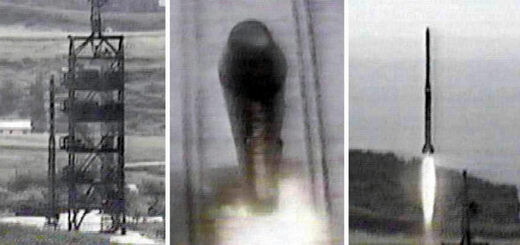hankyoreh
Links to other country sites 다른 나라 사이트 링크
[News Analysis] Question of timing for N.K. missile launch

North Korea fired at least six missiles, the long-range Daepodong-2 and the mid- to short-range Scud and Nodong, consecutively from about 3 a.m. to 8 a.m. on July 5, local time. The weather near the launch side in Musudan-ri, formerly Daepo-dong, Hwadae-gun, North Hamgyeong Province, was not favorable for the test launch. It is common practice not to fire missiles in bad weather, nor at night, but the North proceeded. According to a military expert, the U.S., China, Europe, and Russia have never launched missiles in early morning under bad weather.
The missiles were fired in regular sequence as soon as the United States launched the space shuttle Discovery. The U.S. was celebrating its Independence Day, waiting for news of the space shuttle launch, when they were shocked by the news that North Korea had conducted its launches. This provocative move by the communist regime brought about a crisis on the Korea Peninsula and Northeast Asia. The media worldwide were busy reporting on the North’s missile test-firing and concerned nations’ countermeasures instead of covering the launch of the space shuttle.
An analyst said, "North Korea displayed its missile capabilities by firing missiles on U.S. Independence Day. Such a movement is high-level psychological warfare meant to attract the world’s attention."
The timing of North Korea’s missile launch holds very strong symbolism, not only for inter-Korean relations but within North Korea, as well. The day July 4 is the 34th anniversary of the South-North Joint Statement, and Kim Il-sung died 12 years ago on July 8. The mouthpiece of North Korea’s ruling Workers’ Party, Rodong Sinmun, in an editorial on July 4 stressed that the country’s " ’military-first policy’ will bring prosperity to our fatherland."
When North Korea test-launched a Daepodong-1 missile on Aug. 31, 1998, it had international and domestic intentions in selecting that date, as well. At the time, the Stalinist regime was making attempts to rewin the minds of its citizens under slogans of North Korea as a ’powerful nation’ with a ’military-first policy’ to usher in the so-called Kim Jong-il era after Kim Il-sung had been in power for so long. Kim Jong-il continued his drive to win over the North Korean people by means of the historic inter-Korean summit in 2000 and two North Korea-Japan summits since then, but he may have wanted to reassert himself since George W. Bush took office.
It is highly possible that North Korea was exhibiting its brinkmanship tactics once again. China has stepped up diplomatic efforts by suggesting unofficial six-party talks and President Bush and Japanese Prime Minister Koizumi declared at a summit in Washington on June 29 that they would not accept North Korea’s missile launches. Under such circumstances, Pyongyang fired at least six missiles, including a long-range one, as if to say, "North Korea will never surrender or retreat."
Editorial・opinion
![[Column] Will Seoul’s ties with Moscow really recover on their own? [Column] Will Seoul’s ties with Moscow really recover on their own?](https://flexible.img.hani.co.kr/flexible/normal/500/300/imgdb/original/2024/0513/5917155871573919.jpg) [Column] Will Seoul’s ties with Moscow really recover on their own?
[Column] Will Seoul’s ties with Moscow really recover on their own?![[Column] Samsung’s ‘lost decade’ and Lee Jae-yong’s mismatched chopsticks [Column] Samsung’s ‘lost decade’ and Lee Jae-yong’s mismatched chopsticks](https://flexible.img.hani.co.kr/flexible/normal/500/300/imgdb/original/2024/0512/3017154788490114.jpg) [Column] Samsung’s ‘lost decade’ and Lee Jae-yong’s mismatched chopsticks
[Column] Samsung’s ‘lost decade’ and Lee Jae-yong’s mismatched chopsticks- [Correspondent’s column] The real reason the US is worried about Chinese ‘overcapacity’
- [Editorial] Yoon’s gesture at communication only highlights his reluctance to change
- [Editorial] Perilous stakes of Trump’s rhetoric around US troop pullout from Korea
- [Guest essay] Preventing Korean Peninsula from becoming front line of new cold war
- [Column] The state is back — but is it in business?
- [Column] Life on our Trisolaris
- [Editorial] Penalties for airing allegations against Korea’s first lady endanger free press
- [Editorial] Yoon must halt procurement of SM-3 interceptor missiles
Most viewed articles
- 1Seoul’s plan to adopt SM-3 missiles is like wanting a sledgehammer to catch a fly
- 2[Column] Samsung’s ‘lost decade’ and Lee Jae-yong’s mismatched chopsticks
- 3[Correspondent’s column] The real reason the US is worried about Chinese ‘overcapacity’
- 4Korea poised to overtake Taiwan as world’s No. 2 chip producer by 2032
- 560% of young Koreans see no need to have kids after marriage
- 6[Editorial] Yoon’s gesture at communication only highlights his reluctance to change
- 7Yoon voices ‘trust’ in Japanese counterpart, says alliance with US won’t change
- 8Yoon rejects calls for special counsel probes into Marine’s death, first lady in long-awaited presse
- 9S.K.-Japan joint history project to be revived
- 10Former President Roh Tae-woo, mastermind of 1979 military coup, dies at 88